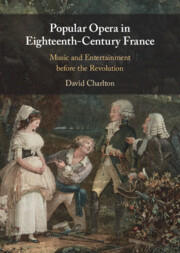Book contents
- Popular Opera in Eighteenth-Century France
- Popular Opera in Eighteenth-Century France
- Copyright page
- Dedication
- Epigraph
- Contents
- Illustrations
- Tables
- Examples
- Preface
- Acknowledgements
- Notes on the Text
- Abbreviations
- 1 Introduction
- 2 Music and Spoken Theatre
- 3 Music in Gherardi’s Company
- 4 Singing and Acting at Home
- 5 Opéra-comique en vaudevilles
- 6 Experiences of Popular Theatre
- 7 Comic and Serious Themes
- 8 Performance as History
- 9 Musical Expansion
- 10 Italian Inroads: The King’s Company
- 11 Six Methods of Synthesis
- 12 A ‘Musico-Dramatic Art’
- 13 Conclusions
- Stage Works Cited
- Bibliography
- Index
4 - Singing and Acting at Home
Published online by Cambridge University Press: 09 December 2021
- Popular Opera in Eighteenth-Century France
- Popular Opera in Eighteenth-Century France
- Copyright page
- Dedication
- Epigraph
- Contents
- Illustrations
- Tables
- Examples
- Preface
- Acknowledgements
- Notes on the Text
- Abbreviations
- 1 Introduction
- 2 Music and Spoken Theatre
- 3 Music in Gherardi’s Company
- 4 Singing and Acting at Home
- 5 Opéra-comique en vaudevilles
- 6 Experiences of Popular Theatre
- 7 Comic and Serious Themes
- 8 Performance as History
- 9 Musical Expansion
- 10 Italian Inroads: The King’s Company
- 11 Six Methods of Synthesis
- 12 A ‘Musico-Dramatic Art’
- 13 Conclusions
- Stage Works Cited
- Bibliography
- Index
Summary
Chapter 4 proposes that popular opera had a ‘binary identity’ because it was understood as a domestic as well as a public entertainment. ‘Contexts’ begins by establishing the prevalence of singing and amateur acting in France. Privileged groups left behind the best record of activity, but Charles Perrault and Le Cerf de La Viéville stressed that opera melodies were sung throughout all social classes. An article by James Parakilas introduces the notion of private performance as a valid aspect of opera history. Arrangements of French opera are demonstrated through early artefacts from Amsterdam and mid-century periodicals from Paris. Solo versions, with texts, of opera overtures and chaconnes are illustrated and contextualised. Laurent Bordelon’s ‘opéra comique’, Arlequin Roland furieux, is identified as the first comedy to bear that designation, conceived for domestic use. The nature and sale of music for Comédie Française plays are described; Jean-Claude Gillier’s music was highly valued. In ‘Those Who Play Instruments’ arrangements of popular opera are studied in relation to the acquisition of musical skills: copying, arranging, figured bass playing. ‘Domestic Operas’ discusses contrasting works made and published for private performance in mid-century: Hautemer’s Le Troc and Marmontel and La Borde’s Annette et Lubin.
- Type
- Chapter
- Information
- Popular Opera in Eighteenth-Century FranceMusic and Entertainment before the Revolution, pp. 77 - 99Publisher: Cambridge University PressPrint publication year: 2021

